It can be quite difficult and dangerous to trim branches and limbs from a tree instead of removing them completely. You will need specific skills for doing so, including tree climbing and pruning. You might often need to use portable power tools like trimmers and chainsaws. Moreover, electrocution and falling from tall trees are two of the leading causes of death while trimming trees. That’s why it’s important to understand tree trimming safety basics so that any kind of tree trimming accident can be avoided.

What is Tree Trimming and Removal Work?
Tree trimming and removal tasks include trimming and pruning, as well as lopping, repairing, removing, and maintaining amenity trees. Ground operations related to tree work, such as root pruning, wood chipping, and stump grinding, are some other related tasks.
Amenity trees refer to the trees that have functional, recreational, social, ecological, health, environmental, or aesthetic value. They are not used for production or agricultural purposes.
Tree Trimming Safety Guide
While you are picking up a pruning saw, you may wonder if you really need to cut off a certain brunch or if you have picked the right time to prune the tree. You can have a proper understanding of all these questions and approach the trimming work in a safe manner by following a proper safety guide for tree trimming.
It is particularly important to follow the safety guide when trimming trees near power lines, removing large dangling or dead branches, or removing large branches near homes or buildings. This guide will help arborists, gardeners, horticulturalists, tree workers, tree climbers, developers, builders, landscapers, and others involved in the amenity tree industry.
This Guide will also be really useful for homeowners and help ensure the safety of other people who can be affected during tree removal and trimming work, including members of the neighborhood.
This tree trimming safety guide consists of 15 safety tips you need to abide by while getting into tree trimming or removal work. Here goes the 15 tree trimming safety tips that you must follow-
1. Choose a Day With Perfect Weather
It’s important to choose a day with good weather for trimming or pruning trees. Late fall, when the trees have shed their leaves, or early winter, is the most suitable time to prune deciduous trees. As the branches will be bare, it will allow you to clearly see the structure of the tree. Trees that are most evergreen should be pruned lightly in late winter. You should avoid major pruning from January through early March, which is also known as the “maple sugar time.”
Also, if the weather forecast for a day looks windy, stormy, wet, or icy, don’t attempt to trim tall trees that require aerial access or climbing. Then you will be able to avoid weather-related danger while conducting the trimming task.
2. Check Out for Potential Hazard
Before trimming or pruning, you must inspect the tree and the ground for potential hazards like electrical lines and broken tree limbs. Make sure to get rid of those hazards before you start working to stay risk-free.
3. Use the Right Tools
Make sure to choose the right tools for your work. Before starting your work, properly assess the things you are going to do during the whole task, and choose the right tools to ensure you can do the work efficiently and safely.
4. Use Protective Equipment
If you are using a chainsaw or a trimmer, it’s best to protect your hands by wearing leather lineman’s gloves. You should also protect your head with a protective helmet or a hard hat, ears with ear protection, and eyes with comfortable eye protection. Also, you should wear shoes with heels and slip-resistant soles to reduce the chance of getting slipped. Wearing long-sleeved and close-fitting clothing with a non-conductive hard hat will help you stay safe if you are working near an electrical wire.
5. Get Proper Training
You must not use a chainsaw or an aerial lift if you don’t have the proper training to do so. So, ensure you have received the proper training to use the tools you need to do trimming or pruning, and also have the training to climb the tree.
6. Ensure Your Tools Are in Good Condition
You must double-check if your tree trimming tools, harnesses, ladder, climbing ropes, and latches are in good condition. Make sure to properly inspect your tools and sharpen them if needed to ensure efficient functioning and safety.
7. Supervise Closely
Before getting into the work, supervise closely for weak or dead tree limbs, and cut off or break if you find any of those are dead. You must not rely on split, weak, or dead branches for support. Make sure to place your hands or feet on separate limbs while climbing and move only one step at a time. You might have to use an aerial lift if the tree is not safe enough to climb.
8. Plan Safety Routes in Case of Emergency
It’s better if you can plan some alternate safety routes in advance in case of an emergency. If you or the people near the work fall victim to any kind of accident, ensure that you have the safety routes planned beforehand. This way, you will be able to minimize the effect of the accident as much as possible.
9. Ensure the Safety of Others in the Nearby Area
Before getting into the trimming work, ensure the safety of your co-workers, passers-by, and other people in the nearby area by marking the work area. If the tree you are working on extends over a road, use signs and cones if you feel it’s necessary to direct people and traffic around the tree. You can also wear high-visibility clothing so that people can notice what’s going on from far away.
10. Eliminate Anything That Blocks Your Sight
If an obstacle keeps blocking your sight, it can cause major issues in your work and increase the risk of accidents. So, it’s important that you eliminate anything that’s blocking your sight before starting the trimming.
11. Mind the Electronics to Avoid Electrical Hazards
Pole trimmers, ladders, and some other pruning tools can conduct electricity if they come into contact with electrical conductors or overhead power lines. A downed power line may still contain enough energy, which can cause serious injuries. So, to ensure proper safety, just assume that the power lines are energized before confirming that they are not. Also, make sure to be highly cautious while moving conductive tools around the power lines.
12. Take Precautions to Avoid Falling
If you are using a ladder to climb up and conduct the trimming work, make sure to tie it properly with a sturdy branch of the tree. If you are making an even higher climb, you must use an aerial lift or a fall protection harness climbing rope. It will protect you in case you fall from the tree accidentally.
13. Assess Post Trimming Hazards
Hazards can still occur after you are done with your trimming work. Assess the hazards that can risk your safety even after the work is done, and make sure to aptly take care of them.
14. Work With a Partner
If you have to climb up a tree, it’s best to work with a partner who stays on the ground during the trimming work. You will need a partner for work within 10 feet of power lines. Also, never do the climb with your tools in your hand. Have your partner pass them up to you after you’ve done the climb.
15. Avoid Trimming Trees Under the Influence of Drugs or Alcohol
It’s a no-brainer that you shouldn’t indulge in any kind of precise work under the influence of drugs or alcohol, and when it comes to risky jobs, you must avoid doing them under that condition. So, make sure that you aren’t drunk or under the influence of any other drugs while you are getting into the trimming or pruning work. Otherwise, you will risk your own life and the lives of other people around the area too.
TIP: If you are concerned about the health and safety of the trees on your property, call (800) 478-7966, our Tree Management Service. Our experienced arborists will assess the health condition of your trees and recommend the best treatment and management plan.
Safety Equipment
You need to use specific tree trimming safety equipment to keep yourself safe from all the potential hazards. Using them is necessary while doing the work; otherwise, you will be a huge risk of various injuries and problems. These equipment are-
1. Hard Hat
You should wear a hard hat to protect your head from the tree’s falling limbs.
2. Non-Slip and Sturdy Boots
You will be able to keep a firm footing on the ground by wearing non-slip and sturdy boots. The risk of slipping and falling will also decrease.
3. Gloves
You need to wear gloves for protecting your hands from cuts and puncture wounds.
4. Climbing Equipment
You need to use specific climbing equipment such as ropes, belts, safety harnesses, carabiners, slings, and lanyards, which will help you conduct the job appropriately. At the same time, they will help you to remain safe and secured while doing the trimming or pruning work.
When you are operating a chainsaw, you will need to wear these specific pieces of safety equipment-
5. Face Shield
You should wear a face shield for protecting your face from debris and the kickback of the machine.
6. Hearing Protection
If you get exposed to loud noises of trimming work without wearing hearing protection, you will lose hearing over time. Plugs and muffs are two common types of hearing protection. Ear muffs will properly seal around your ears to muffle loud noises and keep your hearing safe. Disposable ear plugs have to be discarded after each use.
7. Goggles or Safety Glasses
You must wear goggles or safety glasses during work to keep your eyes safe from foreign objects.
8. Leg Protection
When you are performing ground operations, you must wear leg protection. The material of your leg protection should be cut-resistant. The protection should cover the entire thigh to the top of the boots.
Hire Atlas Tree

As you can see, the tree trimming safety checklist does come with a plethora of things, which can be quite difficult to take care of. On top of that, you may not have all the necessary safety equipment at your disposal. That’s why it’s recommended that you hire expert professionals.
When it comes to professionals, Atlas Tree is one of the bests in Northern California. We have been in the business for more than 40 years and serve hundreds of clients every year. Have a look at our wide range of services.
Final Words
Trimming and pruning trees is not an easy task at all. It is a really complicated and, at the same time, a highly risky task too. Whenever someone gets into trimming or pruning work, they have to face a lot of hazards and dangerous situations. If you are looking forward to trimming a tree, it’s important that you are highly cautious and take proper safety precautions. If you are not cautious enough and fail to take safety measures, you can fall victim to various accidents and injuries. Also, taking safety measures will help you finish your work efficiently too. Moreover, you need to follow the above-mentioned safety guide not only for the safety and efficiency of your work, but you also need to follow those measures to ensure the safety of the people nearby.
Frequently Asked Questions
The most common types of injury during tree trimming are falls, electrocution, and being struck by trees.
Pruning away dead or damaged branches, removing water sprouts, and placing rods across split trunks.
Wrong timing, pruning the wrong branches, trimming the branch collar with the branches, trimming with blunt shears, and neglecting sanitary practices.
